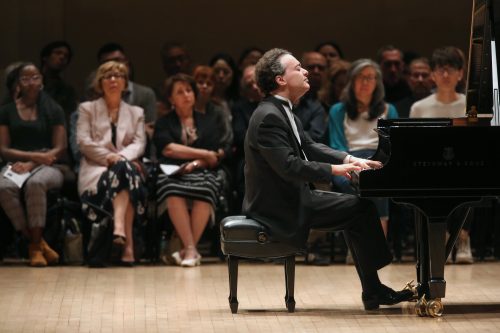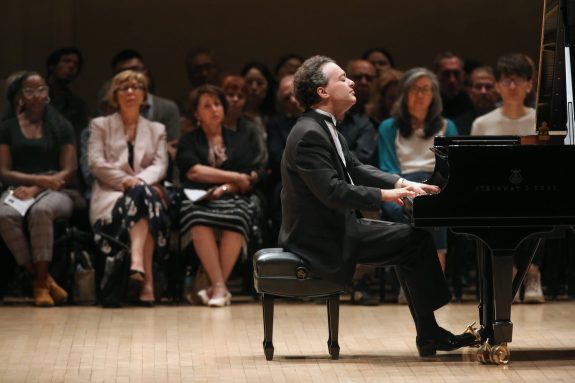 United States Various: Evgeny Kissin (piano). Carnegie Hall, New York, 24.5.2024. (ES-S)
United States Various: Evgeny Kissin (piano). Carnegie Hall, New York, 24.5.2024. (ES-S)

Beethoven – Piano Sonata No.27 in E minor, Op.90
Chopin – Nocturne in F-sharp minor, Op.48, No.2; Fantasy in F minor, Op.49
Brahms – Four Ballades, Op.10
Prokofiev – Piano Sonata No.2 in D minor, Op.14
Now in his early fifties, Evgeny Kissin is significantly older than the current crop of phenomenally talented pianists that crisscross the world stage. Nevertheless, he still occupies the same distinctive and privileged place among interpreters of all generations that he grasped as a child prodigy. His following continues to be huge; it is Kissin and the Berlin Philharmonic that dare to schedule two performances with the same program at Carnegie Hall just a couple of days apart!
Except for Prokofiev’s Piano Sonata No.2, all the other works selected by Kissin for his recital were pieces – some rarely performed – by a few of the greatest piano composers of the nineteenth century. One name was conspicuously absent yet inherently present in the Stern Auditorium. From Beethoven to Chopin to Brahms, the compositions heard in Kissin’s rendition, all using minor key signatures, bore a distinctive Schubertian quality. Melancholy, singing melodies full of emotion and poetic sensibility, an intimate atmosphere, abrupt harmonic and dynamic shifts: all were an integral part of Kissin’s interpretation.
The pianist commenced with Beethoven’s Sonata No.27, a work that occupies a special place in the canon and features characteristics of both his middle and late creative periods. The two movements, one in E minor, vivacious and expressive, and the other in E major, ‘highly songful’, were meant to complement each other. Kissin successfully brought greater unity to the work, imbuing the first movement with spaciousness. He focused less on the consecutive stops and starts or on dynamic shading, and more on rendering an overall sense of longing and even despair. On the other hand, in the second movement with its long, unbroken melody clearly foreshadowing Schubert, he drew attention to contrasting accompaniment details while each repetition of the theme was just a little different.
Chopin’s Nocturne in F-sharp minor and his Fantasy, both conceived in 1831, are representative of the composer’s mature Romantic style. While the former is among the lesser performed of his many mazurkas, the latter stands out as one of his most popular works. The Nocturne had a majestic quality, Kissin less preoccupied by flexible tempos per se than by rendering the melodic lines full of Slavic wistfulness and melancholic undertones. The pianist glided in and out of the middle section – with its change of mode from minor to major and a completely different metric scheme – with utmost subtlety.
Chopin’s Op.49 has a distinct, unconventional form. It opens with two marches, followed by a three-phase development featuring a multitude of themes interspersed with improvisatory statements, and it concludes with an otherworldly finale. In Kissin’s interpretation, the musical material, with its passionate outbursts and great expressiveness, seemed to generate the form instead of rigidly following a pre-imposed one. Both the anguished chorale and the magical Adagio sostenuto figment preceding the fantasy’s final eleven bars seemed to emerge out of nowhere. It was a magisterial performance that provided the audience with their first true glimpse of the pianist’s technical brilliance.
After the interval, Kissin tackled Johannes Brahms’s Ballades Op.10, which are rarely performed as a complete set. It was a restrained interpretation that, once again, de-emphasized robustness in favor of emotional impact, achieved through the blending of narrative and lyrical elements. The grandeur of the D minor Ballade, with its exquisite left-hand accompaniment to the returning theme, was tempered, while the second Ballade was played with great delicacy and sounded very much like one of Schubert’s Impromptus. The more substantial third Ballade was full of little sparks, while in the last one the evocative melodic line floated insouciantly above the overall texture.
Brahms was twenty-one when he composed his Ballades Op.10. Prokofiev was the same age and still a student when he conceived his Piano Sonata No.2. When the recital’s program was initially announced, it included Prokofiev’s Sonata No.7. However, Kissin’s decision to instead draw attention to this lesser-known gem – a worthy predecessor to the so-called ‘war sonatas’ – was certainly meritorious. Like a mischievous wizard, Prokofiev deftly weaves together a universe that straddles tradition and innovation, fierce and bold yet also including moments of tenderness. The pianist relished the chance to bring it to the public.
The first movement was pungent and mysterious. Imbued with sarcasm, the music of the Scherzo was a devilish perpetuum mobile, while the dreamlike Andante was the exact opposite despite its dark undercurrents. A kind of summation of what preceded and demanding virtuosic pianism, the Finale almost brought the listeners to their feet.
Enthusiastically called back to the podium by a roaring audience, Kissin offered ‘just’ three brief encores: Chopin’s Mazurka in A minor, Op.67, No.4; the March from Prokofiev’s The Love for Three Oranges; and Brahms’s Waltz in A-flat Major, Op.39, No.15.
Edward Sava-Segal
